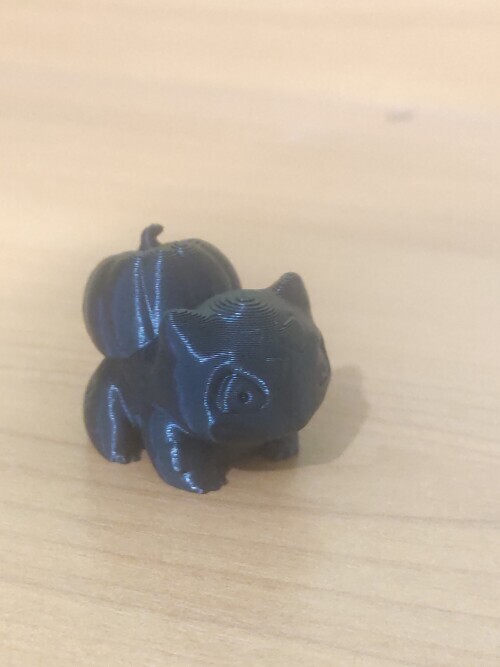Hello Lemmies.
album with photos in order 1-7: https://lensdump.com/a/9Atmx/?sort=title_asc&page=1
EDIT: Direct links may be more convinient pic 1-7
https://i.lensdump.com/i/CbGQ5c.jpeg
https://i1.lensdump.com/i/CbGJv1.jpeg
https://i.lensdump.com/i/CbGtcQ.jpeg
https://i1.lensdump.com/i/CbGrOM.jpeg
https://i1.lensdump.com/i/CbGEDk.jpeg
https://i3.lensdump.com/i/CbGTse.jpeg
https://i2.lensdump.com/i/Cw2uL9.jpeg
I am new to 3d printing as I bought a used Ender3PRO. After initial problems with no adhesion I leveled the bed a couple of tiems. My method is to pinch the paper between the bed and the nozzle to grab and feel a strong friction taking out the paper-sheet. Then in PrusaSlicer I set the Z-offset to 0.2mm and it started printing fine-ish (pic.1, 2, 3 and 4). I made some printer vibrations dampener and figures (around 14 prints ~1,5h each). Next I printed a PS4 Slim Stand (pic.5) and separations between layers appeared.
I increased a bit the temp and run a second piece of the PS4 stand and a dissaster appeared (pic.6) and since then the adhesion to the bed is gone. One in 5 attempts with some glue the filament sticked to the bed, but the next layers have a lot of missplacements and eventually filament sticked arround the nozzle and a destroyed print.
The problems I noticed since the beginning:
- adhesion is not great. The nozzle clean line is 80% of attempts dragged with the nozzle to the center of the bed when the brim starts printing. And gets curved just outside the hotend.
- a 1-2mm of filament is always outside the nozzle (overextrusion?). I usually clean it with my fingers - wrong?
- the printer has a glass bed but I would like to try using the magnetic Ender sheet. The glass is glued to the printer (pic.7)? Can I place the magnetic sheet on the glass? Should I then set Z-offset on the printer settings to avoid nozzle coliding with the bed?
- On retraction, the extruder makes a loud click and sometimes a squeak. Is it normal?
- I had a hard time to put the filament in the tube of the extruder. Like it was missplaced and had to bend the tip of the filament.
- I washed the magnetic sheet with dish-soap and I’ll try my chances today.
- The PLA is black, stock Ender3 filament which I suppose is not best quality, but should be sufficient for start… Im also considering moisture in filament as I don’t have a sperate room for my printer. Pic.6 - can it be caused by moisture?
- After what happender on Pic.6 the extrusion was really poor which I think was due to clogged nozzle. After heating to 240*C, pulling out the filament, needle-cleaning the nozzle the amount of filament extruded returned to what it was at start.
Some settings:
- 205C and 60C for first layer
- 200C and 55C for the rest
- retraction ON
- no Z-hop (I’ll try to avoid it for now, since it didn’t help)
- brim on
- 0,2 layer height
- first layer speed 20mm/s, rest ~40mm/s
Any advice welcome and I’ll provide more info if You have any questions.



Just a thought: Did you clean the bed with isopropyl? I had similar issues with bed adhesion on an Ender3 with the glass bed after a few prints, since I forgot to wipe it down.
On paper-levelling: Yes it’s kind of archaic, but it works. And an Ender3 is entry-level stuff where you have to integrate a BLTouch by yourself and compile marlin - that’s not something you want to do as a beginner.
Soap and warm water is generally preferred to isopropyl, since the alcohol dissolves any fats (e.g. fingerprints) and can spread it out as a thin layer when it evaporates rather than removing it from the bed.
Paper levelling can work, especially with experience, but it’s not a simple formula that all beginners can follow and always end up with a perfectly levelled bed afterwards. I’ve talked to many people who have bought their first printer, followed a paper levelling guide they’ve found, and no matter how many times they’ve tried failed to get good results.
I never mentioned probes though, and even if you buy a BLTouch or similar you have to calibrate the distance between the probe’s trigger point and the nozzle, so it wouldn’t automatically solve initial levelling for a beginner.
The comment derived from me, using a prusa with PEI sheet and their official advice is to wipe it down with isopropyl. But that is totally opinionated and only to be seen as one way to clean your buildplate surface. So, totally fine to use soap and warm water :-) Oh, and it’s more readily available in most cases. But could be a quick fix if fats are the cause for the adhesion problem.
Your statements on levelling and probes are also totally valid. For most people, starting with less sophisticated (cheaper) printers, this is a painful learning curve. But it pays off to understand the overall complexity of 3D printers and finetuning - and it’s fun to experiment.
I mean IPA definitely works as a bed cleaner, one just have to be careful to wipe it off and not let it only evaporate, at least if there were lots of fingerprints on the surface.
Calibrating a 3d printer can almost be seen an art form :) And once on gets the hang of the basics, practice makes perfect. Personally I think I’ve got a good feeling for when calibration looks right now, but in the beginning I also struggled a lot with levelling and adhesion. Unfortunately the “feeling” is something that comes with time, and not something that can be easily conveyed with words to a first time printer.
To make things worse, different factors often influence each other. For example if flow rate is too low, one might try to level the nozzle closer to the bed to compensate. Or if print speed is too high it can look like under extrusion, so a user might incorrectly turn up flow rate.